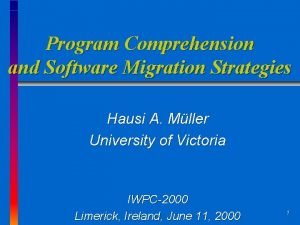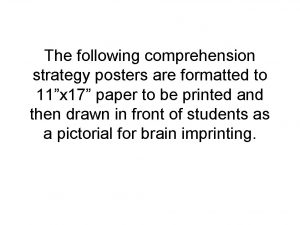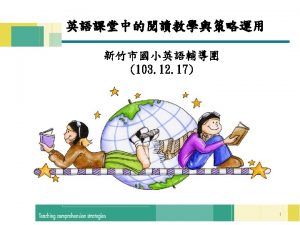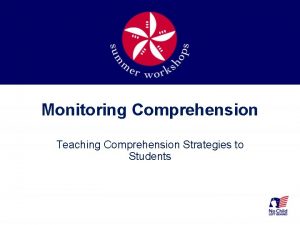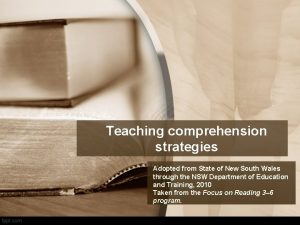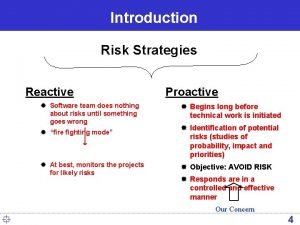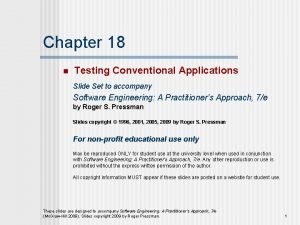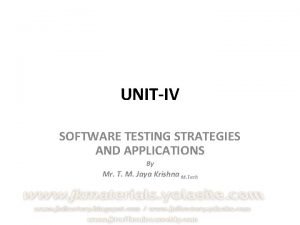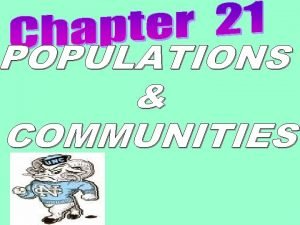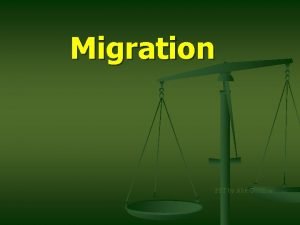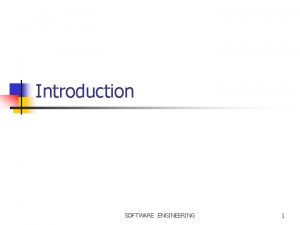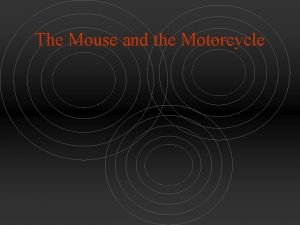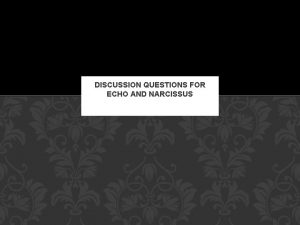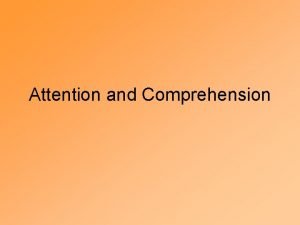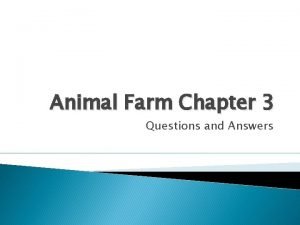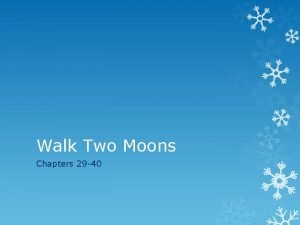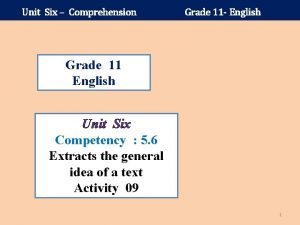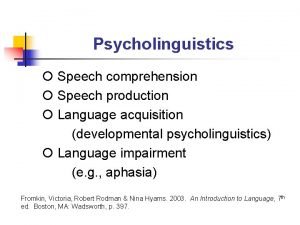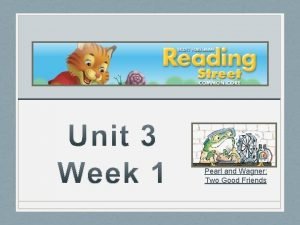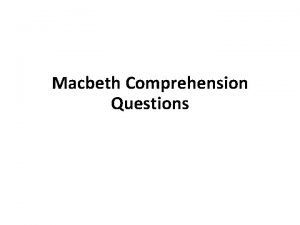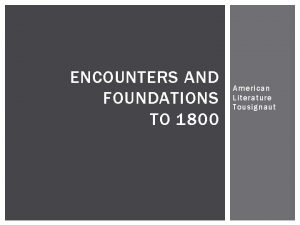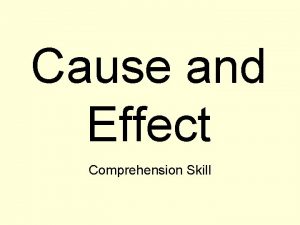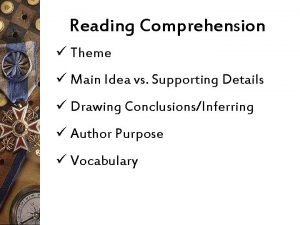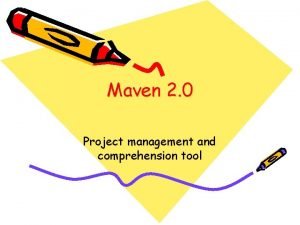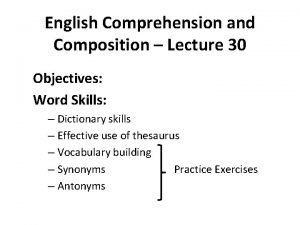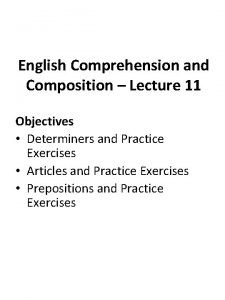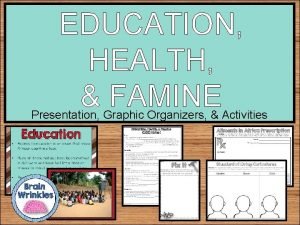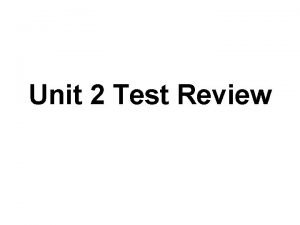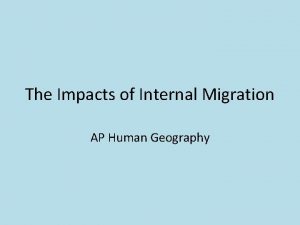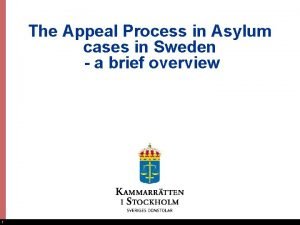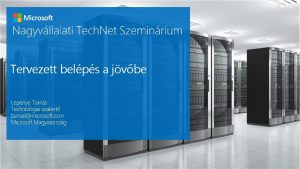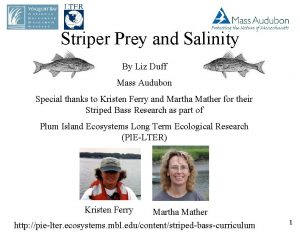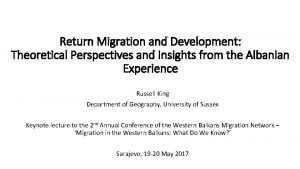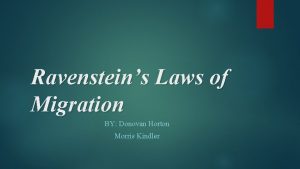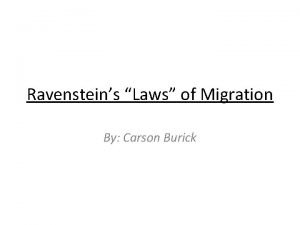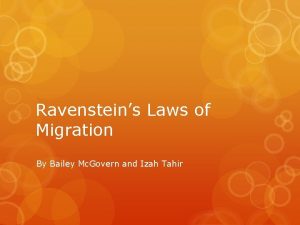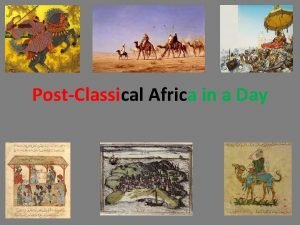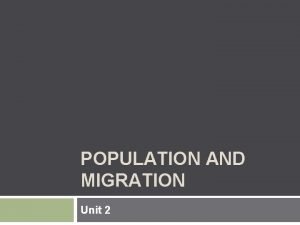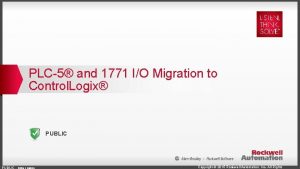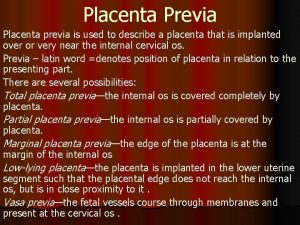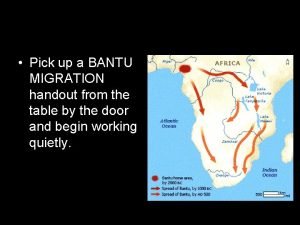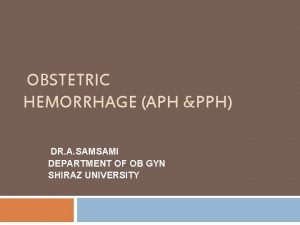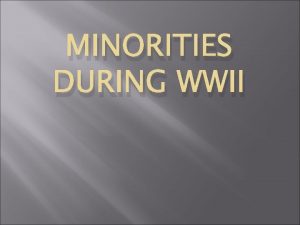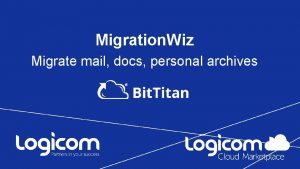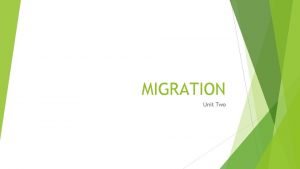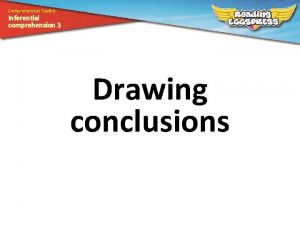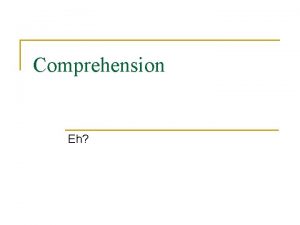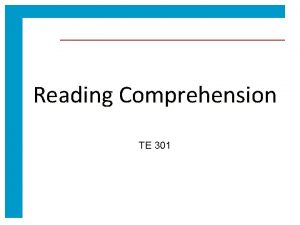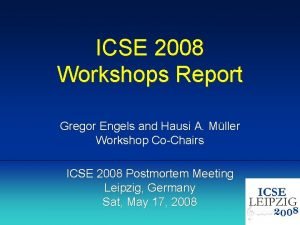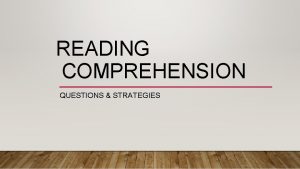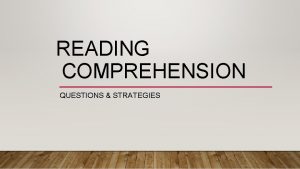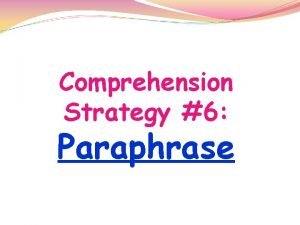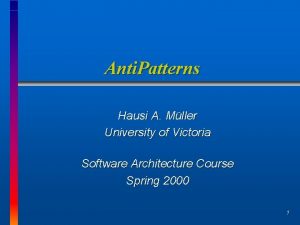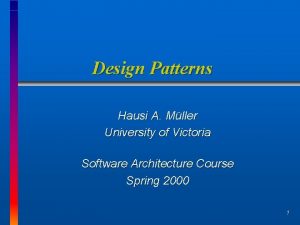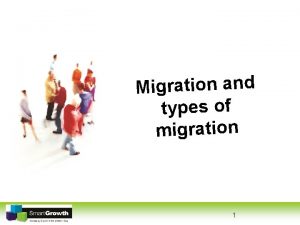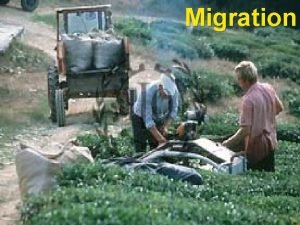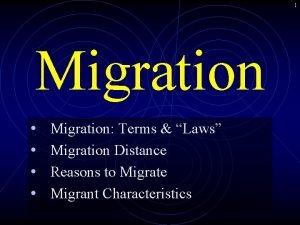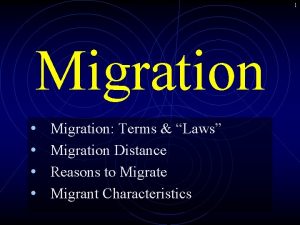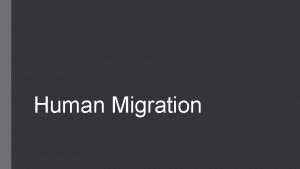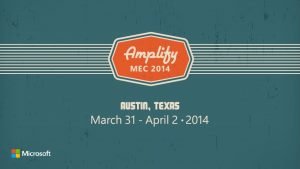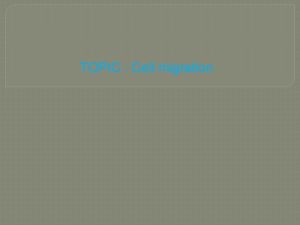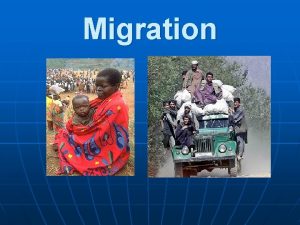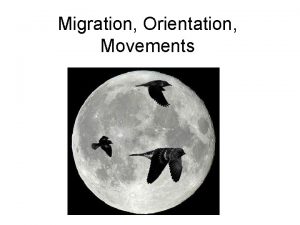Program Comprehension and Software Migration Strategies Hausi A













![The Understanding Gap needed overall understanding [Wong 99] useful, known overall understanding t 1 The Understanding Gap needed overall understanding [Wong 99] useful, known overall understanding t 1](https://slidetodoc.com/presentation_image_h/f9731a9618dcc450e5883d8388e049e5/image-14.jpg)




![Migration Theses n n Management of uncertainty and inconsistency in database reengineering [Jahnke 99] Migration Theses n n Management of uncertainty and inconsistency in database reengineering [Jahnke 99]](https://slidetodoc.com/presentation_image_h/f9731a9618dcc450e5883d8388e049e5/image-19.jpg)










































- Slides: 61

Program Comprehension and Software Migration Strategies Hausi A. Müller University of Victoria IWPC-2000 Limerick, Ireland, June 11, 2000 1

Outline Reengineering categories n Comprehension strategies n Migration strategies n Language migration n Program comprehension education n Mt. St. Helens Theory n Key research pointers n Conclusions n ICSE 2000 Roadmap 2

Research Support ICSE 2000 Roadmap 3

The Horseshoe Model of Software Migration Abstract system Old system New system ICSE 2000 Roadmap 4

Reengineering Categories Automatic restructuring n Automatic transformation n Semi-automatic transformation n Design recovery and reimplementation n Code reverse engineering and forward engineering n Data reverse engineering and schema migration n Migration of legacy systems to modern platforms n ICSE 2000 Roadmap 5

The Horseshoe Model Components Semi-automatic Middleware Abstract system Existing system New system Automatic ICSE 2000 Roadmap 6

Reengineering Categories. . . n Automatic restructuring • to obtain more readable source code • enforce coding standards n Automatic transformation • • • to obtain better source code HTML’izing of source code simplify control flow (e. g. , dead code, goto’s) refactoring and remodularizeing Y 2 K remediation ICSE 2000 Roadmap 7

Reengineering Categories. . . n Semi-automatic transformation • to obtain better engineered system (e. g. , rearchitect code and data) • semi-automatic construction of structural, functional, and behavioral abstractions • re-architecting or re-implementing the subject system from these abstractions ICSE 2000 Roadmap 8

Design Recovery Levels of Abstractions n Application n Function n Structure n Implementation • Concepts, business rules, policies • Logical and functional specifications, non-functional requirements • • • Data and control flow, dependency graphs Structure and subsystem charts Architectures • AST’s, symbol tables, source text ICSE 2000 Roadmap 9

Synthesizing Concepts n n Build multiple hierarchical mental models Subsystems based on SE principles • classes, modules, directories, cohesion, data & control flows, slices n n Design and change patterns Business and technology models Function, system, and application architectures Common services and infrastructure ICSE 2000 Roadmap 10

Modeling Mental Models The Ubiquitous Graph Model Composite node Composite arc Generalization arcs Aggregation arcs Subsystem Classification Typed nodes and arcs ICSE 2000 Roadmap 11

Program Comprehension Technology n Program understanding technology • • • n Cognitive models Levels of abstraction Synthesizing concepts Filtering information Slicing and dicing Comprehension environment • Parsers and lightweight extractors • Repository and conceptual modeling • Visualization. ICSE engines (graph and web based) 2000 Roadmap 12

The Big-Bang Comprehension Problem What can we do during evolution to ease future understanding and migration of information systems? n We know the knowledge we need but it is difficult to obtain from scratch n “Big-bang” comprehension when the system becomes “critical” is high-risk n Analysis paralysis n ICSE 2000 Roadmap 13
![The Understanding Gap needed overall understanding Wong 99 useful known overall understanding t 1 The Understanding Gap needed overall understanding [Wong 99] useful, known overall understanding t 1](https://slidetodoc.com/presentation_image_h/f9731a9618dcc450e5883d8388e049e5/image-14.jpg)
The Understanding Gap needed overall understanding [Wong 99] useful, known overall understanding t 1 t 2 ICSE 2000 Roadmap t 14

Continuous Program Comprehension Apply program understanding continuously and incrementally during evolution of the software system n Use software reverse engineering to re-document existing software n Insert reverse engineering techniques into development [Wong 99] n Symbiosis: models and code [Jackson 00] n ICSE 2000 Roadmap 15

Evaluating Reverse Engineering Tools The purpose of most reverse engineering tools is to increase the understanding an engineer has of the subject system n No agreed-upon definition or test of understanding n Several types of empirical studies that are appropriate for studying the benefits of reverse engineering tools n ICSE 2000 Roadmap 16

Program Understanding Theses An Emerging Discipline n n n Domain retargetable reverse engineering [Tilley 95] Cognitive design elements for software exploration tools [Storey 98] Continuous understanding Reverse Engineering Notebook [Wong 99] Integrating static and dynamic reverse engineering models [Systa 2000] Architectural Component Detection for Program Understanding [Koschke 2000] ICSE 2000 Roadmap 17

Outline Reengineering categories n Comprehension strategies n Migration strategies n Language migration n Program comprehension education n Mt. St. Helens Theory n Key research pointers n Conclusions n ICSE 2000 Roadmap 18
![Migration Theses n n Management of uncertainty and inconsistency in database reengineering Jahnke 99 Migration Theses n n Management of uncertainty and inconsistency in database reengineering [Jahnke 99]](https://slidetodoc.com/presentation_image_h/f9731a9618dcc450e5883d8388e049e5/image-19.jpg)
Migration Theses n n Management of uncertainty and inconsistency in database reengineering [Jahnke 99] Integration and migration of information systems to object-oriented platforms [Koelsch 99] Migrating C++ to Java [Agrawal 99, Wen 2000] An Environment for Migrating C to Java [Martin 2000] ICSE 2000 Roadmap 19

Migration Objectives Evolving Business Requirements Adapt to e-commerce platform n Adapt to web technology n Reduce time to market n Support new business rules n Allow customizable billing n Adapt to evolving tax laws n Reengineer business processes n ICSE 2000 Roadmap 20

Migration Objectives … Software Evolution Requirements Higher productivity n Lower maintenance costs n Move to object-oriented platforms n Inject component technology n Adapt to modern data exchange technology n Leverage modern methods and tools n ICSE 2000 Roadmap 21

Migration Objectives … Software Architecture Requirements Move to network-centric platforms n Integrate cooperative information systems n Leverage centralized repositories n Move from hierarchical to relational db n Take advantage of web user interfaces n Provide interoperability via buses and gateways among applications ICSE 2000 Roadmap 22 n Move to client-server architectures n

Common Requirements Migration n n Ensure continuous, safe, reliable, robust, ready access to mission-critical functions and information • Migrate in place Minimize migration risk • Reduce migration complexity • Make as few changes as possible in both code & data • Alter the legacy code to facilitate and ease migration • Concentrate on the most important current and future requirements ICSE 2000 Roadmap 23

Common Migration Requirements. . . n n Minimize impact on • users • applications • databases • operation Maximize benefits of modern technology • user interfaces, dbs, middleware, COTS • automation, tools ICSE 2000 Roadmap 24

Dimensions of Migration Methods and Tools Automation User involvement manual automatic 10 K 10 M generic Scale specific Domain ICSE 2000 Roadmap 25

Resistance to Change Are some systems more difficult to change, evolve, reengineer than others? n Can we define a measure resistance based on business value, existing technology, new technology, evolution pace? n We need empirical studies. . . n ICSE 2000 Roadmap 26

Separable Tiers n Decompose legacy system into three layers or application tiers • Presentation (interfaces: user and APIs) • Processing (application code, functions, business rules, policies) • Data services (database) n Promotes interoperability, reuse, flexibility, distribution, separate evolution paths ICSE 2000 Roadmap 27

Application Layers User Objects Processing Objects Infrastructure Data Objects ICSE 2000 Roadmap 28

Classification of LIS Architectures n Decomposable • Separation of concerns • Interfaces, applications, db services are distinct components • Functional decomposition • Ideal for migration There is nothing more difficult to arrange, more doubtful of success, and more dangerous to carry through than initiating changes. —N. Machiavelli ICSE 2000 Roadmap 29

Classification of IS Architectures. . . n Semidecomposable • Applications and db services are not readily separable • System is not easily decomposable n Nondecomposable • No functional components are separable • Users directly interact with individual modules n [BS 95] ICSE 2000 Roadmap 30

Migration Strategies n Ignore • retire, phase out, let fail Replace with COTS applications n Cold turkey n • rewrite from scratch • high risk n Integrate and access in place • integrate future apps into legacy apps without modifying legacy apps • IS-GTP [Koelsch 99] ICSE 2000 Roadmap 31

Data Warehousing n Data is needed for several distinct purposes • on-line transaction processing (access in place) • data analysis for decision support applications (extraction of data into an application specific repository) Creates duplicate data n Popular approach n ICSE 2000 Roadmap 32

Gradual Migration or “Chicken Little” Rearchitect and transition the applications incrementally n Replace LIS with target application n Language migration n Schema and data migration n User interface migration n GTE [Br. St 95] n ICSE 2000 Roadmap 33

Chicken Little. . . The intent is to phase out legacy applications over time n In place access is not economical in the long run n More effective, less risky than cold turkey n Allows for independent user interface and database evolution n Incremental n ICSE 2000 Roadmap 34

Chicken Little. . . Legacy and target applications must coexist during migration n A gateway to isolate the migration steps so that the end users do not know if the info needed is being retrieved from the legacy or target system n Development of gateways is difficult and costly n ICSE 2000 Roadmap 35

Opportunistic Migration Method Combination of forward and reverse migration strategies n Forward or reverse migration path per n • • • n operation application interface database site user More complex gateways are needed ICSE 2000 Roadmap 36

Migration Research Method Perform a concrete case study with an industrial software system n Investigate methods and tools to automate the process adopted in the case study n Conduct user experiments to improve the effectiveness of the developed methods and tools n Investigate tool adoption problems n ICSE 2000 Roadmap 37

Language Migration—A Case Study Subject system is a 300 KLOC legacy software system of highly optimized code written in PL/IX n Can the system incrementally be translated to C++? n • Transliteration versus object-oriented design Develop tools which semi-automate the translation process to C++ n The translated code must perform as well as the original code n ICSE 2000 Roadmap 38

Manual Migration First migration and integration effort was completed by hand by an expert [Uhl 97] n 10 person-weeks to migrate 7. 8 KLOC n Successfully passed all regression tests n Built C++ and Fortran compilers with it n It works … … but migrated C++ code was 50% slower than original PL/IX code n ICSE 2000 Roadmap 39

Performance Evaluation Expert identified performance bottlenecks n Hand-optimized migrated code n Optimized version performed better than the original version [Martin 98] n • Up to 20% better than the original code • Now IBM was interested … n Results • Correct, efficient • Translation, integration, optimization heuristics • Incremental process ICSE 2000 Roadmap 40

Automation Can the translation, integration, and optimization heuristics discovered by experts be integrated into an automated tool? n How would it affect the performance? n What existing tools could be leveraged to build such a tool? n Solution n • Use Software Refinery, Reasoning Systems ICSE 2000 Roadmap 41

Transformation Process Transform PLI/IX artifacts to their corresponding C++ artifacts n Generate support C++ libraries (macros for reference components; class definitions for key data structures) n Generate C++ source code that is structurally and behaviorally similar to the legacy source code n CASCON 98 Best Paper ICSE 2000 Roadmap 42 [Kontogiannis 98] n

Results, Morale & Lessons Learned Semi-automatic transformation of large volume of code is feasible n Migrated code suffers no deterioration in performance n Incremental migration process feasible n Technique readily applicable to other imperative languages n Tool reduces migration effort by a factor of 10 over manual migration n CTAS—C++ to Java [Jackson 2000] n ICSE 2000 Roadmap 43

Outline Reengineering categories n Comprehension strategies n Migration strategies n Language migration n Program comprehension education n Mt. St. Helens Theory n Key research pointers n Conclusions n ICSE 2000 Roadmap 44

Teaching program understanding How many teach 4 th year or graduate courses in software evolution, program understanding, comprehension, reverse engineering, reengineering? n How many teach program understanding or program reading in 1 st year? n ICSE 2000 Roadmap 45

Challenges and Aspirations n n Mary Shaw, Software Engineering Education—A Roadmap; in The Future of Software Engineering, ICSE 2000 1. Discriminate among different software development roles 4. Integrate an engineering point of view into CS and IS undergraduate curricula 6. Exploit our own technology in support of education ICSE 2000 Roadmap 46

Discriminate among different software development roles Available knowledge about software exceeds what any one person can know n Specializing roles n Comprehension versus coding skills n Developing the role of a reverse engineer, program comprehender n Software inspection expert n ICSE 2000 Roadmap 47

Integrate an engineering point of view into undergraduate curricula Study good examples of software systems and develop program understanding skills n Teach back-of-the-envelope estimation using reverse engineering technology n Teach students how to investigate nonfunctional requirements using program comprehension technology n ICSE 2000 Roadmap 48

Exploit our own technology in support of education Employ software exploration and reverse engineering tools in 1 st year n Integrated environments such as VA Java or J++ do not provide facilities to explore and record mental models n Familiarize students with software exploration and conceptual modeling tools n Restructure curricula to teach both fresh creation and evolutionary change n ICSE 2000 Roadmap 49

Mt. St. Helens Theory May 18, 1980 Mt. St. Helens self-destructed, setting off the biggest landslide in recorded history and losing 400 meters of its crown n Forests and meadows, and mountain streams were transformed into an ashgray wasteland n Ecologists dogma—nature recreates ecosystems in a predictable fashion n ICSE 2000 Roadmap 50

A decade later even on the most sterile of landscapes brave little vegetative beachheads are formed n The unpredictability of recolonization and the pivotal importance of chance in rebuilding of biological communities n Wildflower gardens, which are mixes of lupine, Indian paintbrush, pearly everlasting, and fireweed, are emerging n ICSE 2000 Roadmap 51

Encourage island-driven research Is program comprehension research becoming too predictable? n Do we need a cataclysmic event to rejuvenate comprehension research? n There are many vegetative beachheads in the community n But they tend to gravitate towards established research and tools n Particularly the tools arena needs new beachheads ICSE 2000 Roadmap 52 n

Outline Reengineering categories n Comprehension strategies n Migration strategies n Language migration n Program comprehension education n Mt. St. Helens Theory n Key research pointers n Conclusions n ICSE 2000 Roadmap 53

Key Research Pointers n Investigate infrastructure, methods, and tools for continuous program understanding to support the entire evolution of a software system from the early design stages to the long-term legacy stages • Reverse engineering notebook ICSE 2000 Roadmap 54

Key Research Pointers. . . Instrument design architecture to ease extraction of understanding architecture n Store architecture artifacts in schemabased repository and as unstructured or Web-based text to ease searching n Allow for incomplete semantics and partial extraction of artifacts n ICSE 2000 Roadmap 55

Key Research Pointers. . . Allow user to build virtual, multiple architectures, perspectives, and views n Provide tools to compare virtual and code-centric architectures (e. g. , reflection models [Murphy 98]) n Make architecture extraction tools enduser programmable and extensible n ICSE 2000 Roadmap 56

Key Research Pointers. . . n Develop methods and technology for computer-aided data and database reverse engineering • Integrate code and data reverse engineering methods and tools • Leverage synergy between code and data reverse engineering communities ICSE 2000 Roadmap 57

Key Research Pointers. . . n Develop tools that provide better support for human reasoning in an incremental and evolutionary reverse engineering process that can be customized to different application contexts • End-user programmable tools • Domain retargetable reverse engineering ICSE 2000 Roadmap 58

Key Research Pointers … n Concentrate on the tool adoption problem by improving the usability and end-user programmability of reverse engineering tools to ease their integration into actual development processes • Start with a web-based user interface • Conduct user studies ICSE 2000 Roadmap 59

Conclusions n Mission statement • Researchers in software design and formal methods should concentrate on software evolution rather than construction • Program understanding and analysis experts should teach their methods in 1 st-year Plenty of research problems n Wonderful case studies n Exciting research!!!! n ICSE 2000 Roadmap 60

Invitation to Visit Canada May 12 -19, 2001 ICSE 2000 Roadmap 61
 Software migration strategies
Software migration strategies 7 comprehension strategies
7 comprehension strategies Comprehension strategies posters
Comprehension strategies posters Super six
Super six Drta reading strategy
Drta reading strategy Super six comprehension strategies nsw det
Super six comprehension strategies nsw det Du path testing
Du path testing Systematic attempt to specify threats to project plan
Systematic attempt to specify threats to project plan Test strategies for conventional software
Test strategies for conventional software Bottom up integration testing
Bottom up integration testing Energy roles
Energy roles Abe goldman
Abe goldman Radial and tangential migration
Radial and tangential migration Differences between sequential and event-driven programming
Differences between sequential and event-driven programming Chapter 3 skills and applications
Chapter 3 skills and applications Generic and customized software
Generic and customized software Difference between student software and industrial software
Difference between student software and industrial software Software measurement and metrics
Software measurement and metrics Unit 1 jobs
Unit 1 jobs The mouse and the motorcycle summary
The mouse and the motorcycle summary Pan african and independence comprehension check answers
Pan african and independence comprehension check answers Echo and narcissus comprehension questions
Echo and narcissus comprehension questions Attention and comprehension
Attention and comprehension Animal farm by george orwell questions and answers
Animal farm by george orwell questions and answers Walk two moons chapter 44
Walk two moons chapter 44 Grade 11 and 12 english reading comprehension
Grade 11 and 12 english reading comprehension Scanning reading benefits
Scanning reading benefits Language comprehension in psycholinguistics
Language comprehension in psycholinguistics Pearl and wagner two good friends
Pearl and wagner two good friends Love is a fallacy comprehension questions and answers
Love is a fallacy comprehension questions and answers Irony in i want a wife
Irony in i want a wife Encounters and foundations to 1800 comprehension answers
Encounters and foundations to 1800 comprehension answers Cause and effect clue words
Cause and effect clue words 1984 questions and answers chapter 1
1984 questions and answers chapter 1 Reading comprehension main idea and supporting details
Reading comprehension main idea and supporting details Maven is a project management and comprehension tool
Maven is a project management and comprehension tool Using a thesaurus
Using a thesaurus English comprehension and composition
English comprehension and composition Levels of consumer decision making
Levels of consumer decision making Being resourceful meaning
Being resourceful meaning Social factors migration
Social factors migration Thomas malthus concluded that
Thomas malthus concluded that Internal migration definition ap human geography
Internal migration definition ap human geography Migration court of appeal stockholm
Migration court of appeal stockholm Windows server migration tools
Windows server migration tools Liz duff
Liz duff Migration hump
Migration hump Ravensteins laws of migration
Ravensteins laws of migration Ravensteins laws of migration
Ravensteins laws of migration Ravenstein's laws of migration definition
Ravenstein's laws of migration definition Bantu migrations
Bantu migrations Zelinsky's migration transition
Zelinsky's migration transition Zelinsky's migration transition
Zelinsky's migration transition The migration of darkness analysis
The migration of darkness analysis Plc5 to controllogix conversion
Plc5 to controllogix conversion Placenta prvia
Placenta prvia Bantu migration in africa
Bantu migration in africa Placental migration
Placental migration Second great migration
Second great migration Wiz migration
Wiz migration What is migration
What is migration Zelinsky's migration transition
Zelinsky's migration transition
